Analyzing Attribution Data and Driving Decisions

Congratulations! By now, you’ve set up your attribution framework, implemented tracking systems, and captured valuable touchpoint data. The next step is where the magic happens: analyzing your attribution data to extract insights and make informed marketing decisions.
For herdr.io, this means understanding how each channel (like LinkedIn Ads, newsletters, Google Search Ads, and more) contributes to trial signups, engagement, and revenue. In this article, we’ll explore methods for interpreting attribution data, identifying actionable insights, and driving smarter business decisions.
1. Understanding Your Attribution Reports
Attribution reports provide a breakdown of how credit for conversions is assigned to different channels or touchpoints. These reports vary depending on the tools and models you’re using but generally include metrics like:
- Conversions by channel: Which channels drive the most direct or assisted conversions?
- Revenue attribution: How much revenue is attributed to each channel or touchpoint?
- Conversion paths: Common sequences of touchpoints leading to conversion.
Example Report Insights for herdr.io:
- LinkedIn Ads: Drives significant first-touch interactions but fewer direct conversions.
- Google Search Ads: Contributes to a high percentage of last-touch conversions.
- Email Newsletters: Play a key mid-funnel role in nurturing leads to conversion.
Familiarize yourself with the data structure and visualization tools in platforms like Google Analytics 4 (GA4), your CRM, and attribution software.
2. Identifying Key Attribution Metrics
Focus on the metrics that align with your marketing goals:
Awareness Metrics:
- Impressions and reach: Understand which channels introduce your brand to the most people.
- Top-of-funnel traffic: Analyze the percentage of new visitors driven by channels like LinkedIn Ads.
Consideration Metrics:
- Engagement rate: Identify which blogs, emails, or ad creatives hold the audience’s attention.
- Multi-touch influence: See how middle-funnel content (e.g., newsletters) assists conversions.
Decision Metrics:
- Cost per acquisition (CPA): Evaluate the cost-effectiveness of bottom-funnel channels like Google Search Ads.
- Return on ad spend (ROAS): Measure revenue generated compared to ad spend for paid campaigns.
Retention Metrics:
- Customer lifetime value (CLV): Compare the value of customers acquired via different channels.
3. Spotting Patterns and Trends
Conversion Path Analysis
Review the common sequences of touchpoints in customer journeys:
- Are most users discovering you through LinkedIn Ads before moving to Google Search Ads?
- Do blog visitors often subscribe to your newsletter before signing up for a trial?
Attribution by Channel
Analyze the role of each channel in your funnel:
- Top performers: Channels driving high conversions or awareness.
- Undervalued channels: Channels with significant assisted conversions (e.g., blogs).
- Underperformers: Channels with high costs but low impact.
Seasonal or Campaign Trends
Examine how performance fluctuates:
- Does LinkedIn Ad performance improve during quarterly product launches?
- Are newsletter sign-ups higher after publishing specific types of blogs?
Example for herdr.io:
- LinkedIn Ads dominate early touchpoints, while Google Search Ads are critical for trial signups.
- Blog posts covering “SaaS work management tips” show higher mid-funnel engagement than general content.
4. Taking Action: Optimizing Your Marketing Strategy
The goal of attribution analysis is to improve decision-making. Use the data to refine campaigns, allocate budgets, and test new ideas.
Reallocate Budgets
- Invest more in top-performing channels like LinkedIn Ads for awareness or Google Search Ads for conversions.
- Reduce spend on channels with high CPA or low ROAS.
Refine Campaigns
- Double down on high-performing blog topics or ad creatives.
- Improve underperforming campaigns by testing new messaging, visuals, or offers.
Strengthen the Funnel
- Develop more content or campaigns for critical mid-funnel channels like newsletters.
- Address drop-offs in the customer journey with retargeting ads or optimized landing pages.
Example Decisions for herdr.io:
- Shift budget from Facebook Ads to LinkedIn Ads for better top-of-funnel awareness.
- Create new blogs targeting high-interest keywords identified from organic search data.
5. Testing and Iterating
Attribution is not a set-it-and-forget-it system. Continuously test your assumptions and refine your approach:
A/B Testing
- Run A/B tests on ad creatives, landing pages, or email subject lines to improve performance.
Attribution Model Testing
- Experiment with different attribution models (e.g., first-touch vs. position-based) to see how they affect insights.
Performance Reviews
- Schedule regular reviews to compare metrics over time and assess the impact of optimizations.
Example Iteration for herdr.io:
- After noticing undervalued contributions from blog content, switch to a data-driven attribution model to better measure its role in assisted conversions.
6. Communicating Insights to Stakeholders
Attribution insights are powerful tools for aligning your team and justifying decisions. Use clear, visual reports to communicate:
- Channel performance summaries.
- ROI calculations for key campaigns.
- Data-backed recommendations for budget adjustments or new strategies.
Example:
Share a report showing how LinkedIn Ads drive 60% of first-touch traffic and recommend increasing spend by 20% to expand top-of-funnel growth.
Next Steps: Scaling with Confidence
Now that you’ve mastered analyzing attribution data, you’re ready to scale. In the next article, we’ll cover how to evolve your attribution strategy over time, ensuring it adapts as your business and campaigns grow.
Read Next: Evolving Your Attribution Strategy Over Time →
Final Thoughts
Attribution analysis isn’t just about assigning credit; it’s about driving smarter decisions. By understanding channel performance, spotting trends, and continuously optimizing, herdr.io can make the most of its marketing investments.
Stay curious, test your assumptions, and let the data guide you. With this approach, you’ll build a marketing machine that’s efficient, effective, and ready to scale.







